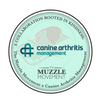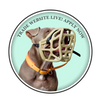Dog Muzzle Legislation around the World
Dog guardians all over the world are utilising muzzles for their dogs, for a variety of reasons, such as;
keeping dogs, people and animals safe, reducing the risk of scavenging, dogs who nip and grab when excited or frustrated or simply in the case of an emergency.
In many places, dogs are legally required to be muzzled due to laws and legislation. According to DogsBite.org [1],
Here, we will take a look at the various reasons dogs may be muzzled in some countries.
United Kingdom
Here in the UK, thousands of dogs are muzzled at all times in public places due to breed specific legislation. 5 types of dogs are illegal in the UK, this means they cannot be sold, bred from, be abandoned or given away.
These are Dogo Argentino, Fila Brasileiro, Japanese Tosa, Pit Bull Terrier and XL Bully.
Dogs who are deemed to be these breed or types may be taken away, and some guardians are able to apply for a Certificate of Exemption if the dog has not behaved dangerously.
Exempt dogs must be kept on lead and muzzled at all times in public by law.
It is also a criminal offence to allow a dog of ANY breed to be dangerously out of control in a public place. The dog doesn’t need to show aggressive behaviour or bite to be considered out of control, it can be deemed as dangerous by causing ‘fear or apprehension to a person that it may injure them’.

Guardians of these dogs may be taken to court where the magistrate will decide if the dog should be seized and destroyed or placed on a Control Order which may include being muzzled in public places. [2]
United States of America

In America, the laws regarding muzzling dogs varies in different states, counties and cities. There are believed to be over 1000 cities in American with bans or restrictions on Pit Bulls, Wolf-Dog hybrids, Dogo Argetinos, Presa Canarios, Cane Corso, Rottweilers, Chow Chows, Akitas, German Shepherds, Caucasian Shepherds among others. [1]
These restrictions can include the dog being on a lead and muzzles in public places.
Germany

In Germany, Dangerous Dogs are regulated by law. A dog is considered dangerous if they have shown aggression, injured people or show inclination to attack livestock/game. There are 3 breeds automatically regulated too, the Pit Bull Terrier, American Staffordshire Terrier and Staffordshire Bull Terriers, as well as any crosses of these breeds.
These dogs cannot be bred, sold or imported in/to Germany and Guardians must apply to their local authority to gain permission to have one as well as meet certain criteria.
These dogs just be on a lead and muzzled in all public areas. [3]
France
In France, there are some types of dogs which are considered ‘Category Dogs’. Guardians of category dogs can apply for a license to keep their dog.

Category 1 dogs are deemed as attack dogs must physically resemble: American Pit Bull Terriers, Mastiffs and Tosa. These dogs are not allowed to be bred, bought, sold or given away. Category 1 dogs are not allowed in public places or on public transport.
They must be muzzled and on lead on public highways and in common areas of public buildings.
Category 2 dogs are deemed as guard and defensive dogs. The breeds included are American Staffordshire Terriers, Rottweilers and Tosa. Category 2 dogs must be muzzled and on a lead on public roads, common areas of public buildings, in public places, on public transport and in premises open to the public. [4]
All dogs over 6kg must be muzzled and kept onlead when using most public transport in France, though the rules vary from city to city. Dogs under 6kg must be secured in a bag, carrier or basket. [5]
Australia
Rules vary from state to state but generally there are dangerous dog regulations.

For example, in Queensland, there are 5 prohibited breeds; Dogo Argentino, Fila Brasileiro, Japanese Tosa, American pit bull terrier and Presa Canario.
Any breed can also be deemed ‘dangerous or menacing’ if they have, or may, attack or act in a way that causes fear to a person or animal.
Regulated dogs must wear a distinctive collar to identify them – these are red and yellow striped.
Amongst other requirements, the dog must be muzzled in public places (for regulated and dangerous dogs, but not menacing dogs). [6]
In some states, Greyhounds need to be muzzles and on lead in public places too, though a few states have recently removed this rule.
Italy

In Italy, there is a law that all dogs must remain on lead at all times and that all dogs must be muzzled in public,
however this doesn’t seem to be enforced, and guardians are encouraged to carry a muzzle with them just in case it is needed. [7]
Canada
Regulations and rules vary from city to city in Canada, but in Toronto, authorities can issue Dangerous Dog Orders for dogs who have been involved in dangerous incidents. These dogs must be muzzled at all times except on their guardian’s property. [8]

In Edmonton, dogs must be muzzles when off the guardian’s property if they are deemed a ‘restricted dog’. These means the dog has had two instances of chasing, attacking or biting a person or animal with or without causing minor physical injury, or one instance causing physical injury. [9]
Different provinces of Canada have breed specific legislation. Some of the breeds included are; Pit bull terrier, American Staffordshire Terrier and Staffordshire Bull Terrier.
Ireland

Ireland has breed specific legislation meaning that Staffordshire bull terriers, American pit bull terriers, English bull terriers, Bullmastiffs, Dobermanns, German shepherds, Rhodesian ridgebacks, Rottweilers, Japanese akitas, Japanese tosas and Bandogs must be kept on a lead and muzzled at all times in a public place. [10]
We have helped and supported many breeds of dogs & their Guardians with our muzzles.
We ship worldwide and also have muzzle fitting affiliates based around the world. Please checkout our Affiliate map, where if you need help with sizing or fitting they maybe able to help you. Read More
Resources used for this blog.
[2] https://assets.publishing.service.gov.uk/media/5a755914ed915d6faf2b24bc/dogs-guide-enforcers.pdf
[3] https://www.ramstein.af.mil/About/Fact-Sheets/Display/Article/303687/dog-keeping-laws-for-germany/
[6] https://www.qld.gov.au/families/government/pets/regulated-dogs#declared
[9] https://www.edmonton.ca/residential_neighbourhoods/pets_wildlife/restricted-dogs
[10] https://www.ikc.ie/dog-ownership/choosing-the-right-dog/legal-requirements/






